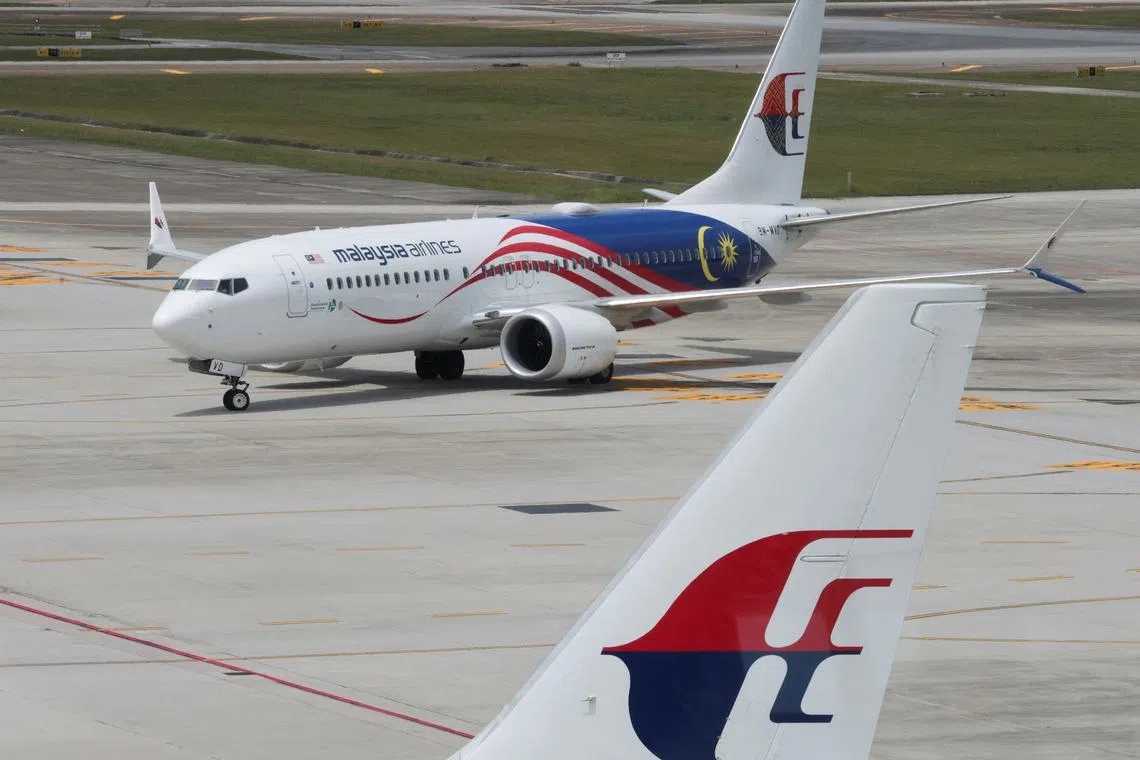‘What happened to Malaysia Airlines?’: KL takes steps after national carrier forced to cut flights
Sign up now: Get insights on the biggest stories in Malaysia

Mechanical issues and a shortage of skilled aircraft maintenance workers were among key factors that affected the group.
PHOTO: REUTERS
Follow topic:
KUALA LUMPUR - The Malaysian government is moving to tackle serious issues faced by Malaysia Airlines that have forced the national carrier and its two sister airlines to reduce flight frequencies and routes until December, Transport Minister Anthony Loke said on Aug 28.
He said mechanical issues and a shortage of skilled aircraft maintenance workers were among key factors affecting the group, following three incidents in August involving Malaysia Airlines
Two flights had to turn back to Kuala Lumpur International Airport due to technical problems while in the air. A third flight en route to Kuala Lumpur from Melbourne had to make an emergency landing at Alice Springs
As part of a mitigation plan to resolve these issues, the group must aggressively recruit new personnel, procure sufficient replacement parts and carry out auditing more frequently, said Mr Loke.
Following an investigation into the issues, Malaysia’s civil aviation regulator has made the drastic move to cut the renewal period of the flag carrier’s Air Operator Certificate to one year, from three years, he told a news conference.
The move would ensure higher safety levels, as this means more frequent aircraft audits by the Civil Aviation Authority of Malaysia.
The airline’s parent, Malaysia Aviation Group (MAG), is under the purview of national sovereign wealth fund Khazanah Nasional. The group also operates short-haul service Firefly and pilgrimage-flight unit Amal.
Mr Loke also said that from Sept 2, all airlines will have to provide full refunds to passengers
The news conference was held after MAG’s announcement on Aug 24 that it would reduce flights and routes across its carriers until December, after the spate of incidents involving its flights in August.
Mr Loke said that 63 out of the 411 skilled workers at the Malaysia Airlines engineering department had left the company since January, likely for Middle Eastern airlines or Singapore, due to the higher salaries they offer.
“Malaysia Airlines has also outlined a mitigation plan with an emphasis on ensuring aircraft safety to improve its reliability. Recruitment programmes will also be carried out aggressively by the airline,” stressed Mr Loke, who became the transport minister in December 2022.
Former transport minister Wee Ka Siong said on Aug 23 that recent incidents involving Malaysia Airlines aircraft have led to a “crisis of confidence” among passengers.
“The public is asking, ‘What has happened to Malaysia Airlines? Is it safe to fly with them?’” he wrote in a Facebook post.
Aviation analysts say reducing the number of flights temporarily is the right thing to do, and that the national carrier can bounce back from this.
Mr Shukor Yusof, founder and analyst at Singapore-based aviation advisory firm Endau Analytics, told The Straits Times that the airline’s technical difficulties arising from supply chain snags, manpower shortage and delays in deliveries of new planes are problems also faced by other airlines in the post-pandemic era.
“The decision to cut frequencies (of flights and routes) is the right move, as safety is paramount. It (the carrier) can fully recover once it stabilises these technical problems,” he said.
While the move will wipe out the gains it has made so far in 2024, he said it would not be as bad as the brand damage suffered by the loss of two planes in 2014.
Malaysia Airlines was rocked that year by the disappearance of MH370 and the downing of MH17 over Ukraine.
In November that year, MAG – led by group managing director and chief executive officer Izham Ismail – was set up, replacing Malaysian Airline System.
Mr Shukor estimates that a million passengers will be affected by Malaysia Airlines’ decision to reduce its flight frequency and route network between now and December, resulting in losses that could run in the hundreds of millions of ringgit.
“This means MAG will end its financial year deep in the red, despite having been cash-positive for much of this year,” he wrote in a post on LinkedIn on Aug 26.
Malaysia’s national carrier group has been bailed out three times in the past, costing taxpayers billions of ringgit. But in March 2024, MAG posted a RM766 million (S$230 million) net profit
Mr Brendan Sobie, founder of Singapore-based aviation consulting firm Sobie Aviation, said in his LinkedIn post on Aug 27: “Consumers will see higher fares and inevitably complain along with politicians. But the capacity cuts by MAG and the response by competitors are sensible – and over the long term should improve the health of Malaysia’s airline sector.”


